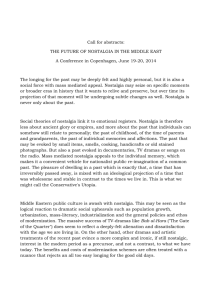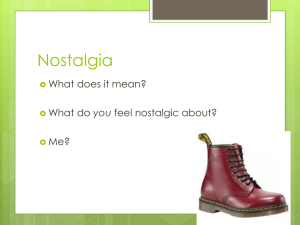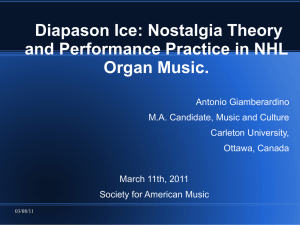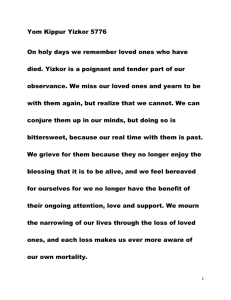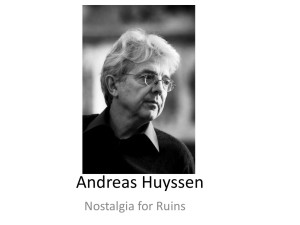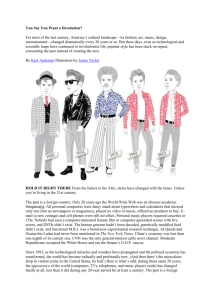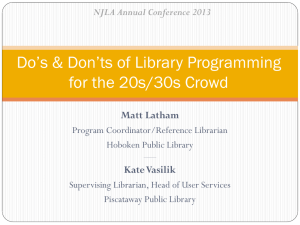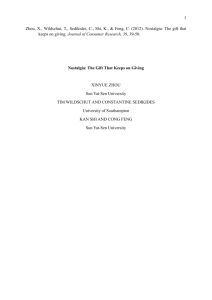- Middlesex University Research Repository
advertisement
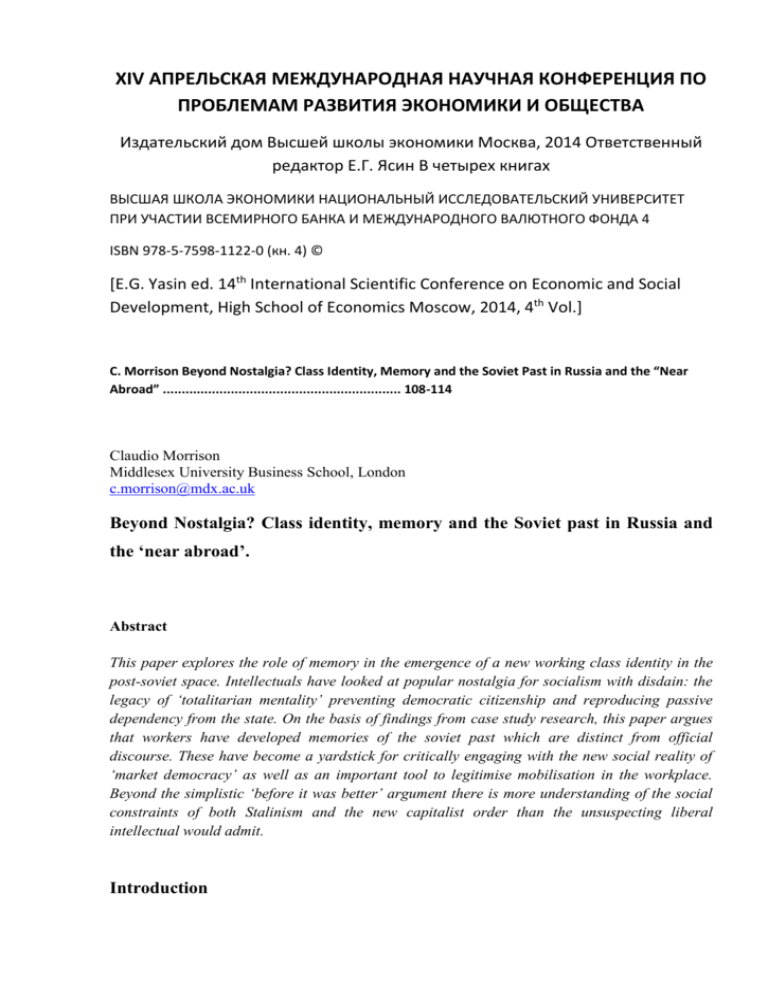
XIV АПРЕЛЬСКАЯ МЕЖДУНАРОДНАЯ НАУЧНАЯ КОНФЕРЕНЦИЯ ПО ПРОБЛЕМАМ РАЗВИТИЯ ЭКОНОМИКИ И ОБЩЕСТВА Издательский дом Высшей школы экономики Москва, 2014 Ответственный редактор Е.Г. Ясин В четырех книгах ВЫСШАЯ ШКОЛА ЭКОНОМИКИ НАЦИОНАЛЬНЫЙ ИССЛЕДОВАТЕЛЬСКИЙ УНИВЕРСИТЕТ ПРИ УЧАСТИИ ВСЕМИРНОГО БАНКА И МЕЖДУНАРОДНОГО ВАЛЮТНОГО ФОНДА 4 ISBN 978-5-7598-1122-0 (кн. 4) © [E.G. Yasin ed. 14th International Scientific Conference on Economic and Social Development, High School of Economics Moscow, 2014, 4th Vol.] C. Morrison Beyond Nostalgia? Class Identity, Memory and the Soviet Past in Russia and the “Near Abroad” ............................................................... 108-114 Claudio Morrison Middlesex University Business School, London c.morrison@mdx.ac.uk Beyond Nostalgia? Class identity, memory and the Soviet past in Russia and the ‘near abroad’. Abstract This paper explores the role of memory in the emergence of a new working class identity in the post-soviet space. Intellectuals have looked at popular nostalgia for socialism with disdain: the legacy of ‘totalitarian mentality’ preventing democratic citizenship and reproducing passive dependency from the state. On the basis of findings from case study research, this paper argues that workers have developed memories of the soviet past which are distinct from official discourse. These have become a yardstick for critically engaging with the new social reality of ‘market democracy’ as well as an important tool to legitimise mobilisation in the workplace. Beyond the simplistic ‘before it was better’ argument there is more understanding of the social constraints of both Stalinism and the new capitalist order than the unsuspecting liberal intellectual would admit. Introduction Debates around nostalgia in the 1990s have highlighted the relationship between historical memories, the interpretation of the socialist past and the formation of the ideological framework underpinning transformations in post-socialist societies (Modrzejewski and Sznajderman, 2003). Intellectuals first observed in disbelief as disillusionment with reforms gave rise to nostalgia for the socialist system. They denounced risks that ultra-nationalist groups and official politicians could manipulate these feelings. They also identified a trend where private corporations turn the past into a commodity, following US models, for image and sales purposes. In the last decade, as to confirm it, Czarism, Stalinism and other country-specific ingredients appear being conveniently channelled into patriotic syntheses. Against such distortions, intellectuals have elaborated their own memories, contrasting ‘reactionary’ nostalgia with a ‘reflective’ approach which, like a broken glass, renounces any totalitarian wholesomeness, celebrating the private and the individual. Likewise, employment relations scholarship has relied on the belief about the existence of ‘totalitarian’ culture in socialism, breeding worker’s passivity in the region (Crowley and Ost, 2001). In this paper we maintain that such approaches from above ignore the real possibility for historical reflections from below. For all their critical potentials towards political manipulation, nostalgia narrated by intellectuals is very much their own nostalgia, i.e. their social point of view. It ignores the social reality of work and its agents, revealing both a gap and a bias in postsocialist scholarship. Workplace ethnography (Burawoy, 1998) reveals historical memories which are both clearly demarcated by social position as well as clearly reflexive in identifying elements of the past. The paper will expand on the contributions and limitations of ‘intelligent nostalgia’ before exploring class memories emerging from our own case study research. ‘Intelligent nostalgia’: between liberal dreams and socialist nightmares In the essential reading on Nostalgia Svetlana Boym (Modrzejewski and Sznajderman, 2003, pp. 59-68) articulate what we can be defined as bad and good nostalgia. The former selectively rearranges past memories to form a flawless whole, a mythical golden age to which the nostalgic yearns to return – in our case socialism or the Soviet Union. This is at better an escapist strategy to turn away from the vagaries of the present time, otherwise it can turn into a dangerous misunderstanding of the ‘totalitarian’ past open to all sort of manipulations. A likely outcome, taking the US example, is offered by Hollywood styled nostalgia ‘on demand’ used by marketers and politicians alike to normalise history and legitimise the present. While these threats have proved more than real it is already questionable whether in fact popular nostalgia can be equated to the uses made by the wealthy and powerful. Good or reflective nostalgia proves equally problematic if not more revealing. Reflective nostalgia, she reasons, is based on recognising that an era has concluded, what once was, it is no more. Nostalgia then consists in a method; a process which ‘historicize’ memories. Taking the lessons of the early surrealists it browses memory, as they did the bazars for bits of the past in order to create fragmented compositions. This type of nostalgia seems able to only generate literary delights rather than punctual views of any clarity. This is maybe because, she insists, the first type concerns the state or nations; the second one instead concerns the private life of the writer intellectual, as perfectly exemplified by most papers in the collection. The unwritten assumption which resonates with more than a single publication is that any form of nostalgia for socialism as such is anathema. Nostalgia in this context can only be the celebration of the private life of the individual away from the clasps of the totalitarian state. Such approach embraces individualism and as such it can only produce stories or a very biased history rather than a collectively shared one. In present terms, it complements the liberal agenda of a westernised intelligentsia (Lester, 1995). Paradoxically, this approach is admittedly reflect-ive, i.e. it is obsessed with the self of the writer and sees nothing else, but certainly proves not reflexive, that is able to offer a reliable and representative account. This is because it fails to recognise the social position from which the analyst begins her/his research, an issue specifically identified by Bourdieu (2001) in the case of intellectuals studying mass culture. Taking their own political taste and expectations as a measure of judgment, most post-socialist intellectuals disregard the aspirations of the working masses in their countries, which felt often perfectly content with a substantial part of what the socialist system had to offer (Modrzejewski and Sznajderman, 2003, pp. 260-277). The condition of separation and marginalisation that was imposed on the intelligentsia by Stalinism may explain both its dislike of the system and of workers as its nominal beneficiaries (Di Leo, 2012). This paper attempts at redressing this bias about popular nostalgia by searching for articulated historical memories from, and about the workplace. Nostalgia in the Russian workplace: making sense of transition Crossing factory gates in the late 1990s, as I did to research a factory town in the upper Volga, provided from the start a different prospective on the fast disappearing soviet way of life (Morrison 2007). There was neither idolisation of socialism nor enthusiasm for fast advancing capitalist restoration (Kagarlitsky, 1995). First, the ‘before was better’ argument appeared obvious when workers referred to concrete things such as shrinking wages and social provisions, the ever growing workload and the loss of voice they exercised in everyday work life (Clarke, 2007). It was also clear, though, that different groups had diverging views. The ubiquitously praised ‘stability’ meant constant supplies, secure markets and unchallenged authority for red directors and their accolades. They were happy instead to do away with stable employment and wages which workers missed the most. The latter, by the same token, did not present a uniformly positive view of the system. They nostalgically remembered the time when their work was morally and materially rewarded: their pictures on the doska pochety, the bonuses for over-fulfilment. Nonetheless they were well aware that social divides had always existed: ‘There are those who physically make and remake the world with their bare hands and those above simply sitting back and talking people round’ (Vitya, Russia 2001). Only now they had grown even wider. After all, Yeltsin’ reforms were never meant to bring democracy into the workplace - another respondent, Nadya, stated - this was briefly the case with early Perestroika but it quickly evaporated. Workers could also recognise variations over historical time. Nadya’s mother, who lost an arm in the textile factory, recalled how under Stalin workers could be jailed for a five minutes delay even in cold winters and there was never time to go out: ‘no dances in our youth, back from the factory we just went to sleep’. More ominously, a veteran worker referred to the repressions in the 1930s when trucks came in to take people, women included, ad no violence was spared. Kolya, top manager and key respondent, maintained that fear was ever present and justified why workers would not volunteer individual interviews. These workers surely cannot feel nostalgia for authoritarian rule, if nothing because it never truly went away; what they meaningfully regret is the loss of the social arrangements that under socialism justified it. Continuity of power also explains why perceived unfairness of reforms does not generate open conflict. In Moldova, an ex-soviet republic which has experience a more radical breakup of political infrastructures and introduction of western management, greater clarity of class change and opportunities for agency can be observed. The Moldovan cases: soviet past versus capitalist modernisation The in-depth study in 2004-2007 of two soviet clothing enterprises, which had undergone restructuring by Western owners, allowed observation of old employees’ reaction to changes in the labour process, revealing awareness but also diverse forms of nostalgia among respondents (Morrison and Croucher, 2010). Tanya, trade union official explains: ‘the payment system before was better. Basically now we have no incentive mechanism . . . foreign investors are satisfied: good workmanship and cheap labour’; Alla, the brigade leader - ‘in USSR after work we would go to the cinema or similar: life was easier . . . tasks were always the same: we could work and have a chat at the same time’; but Tanya, seamstress - ‘relations with management have become hastier’, and also, ‘before the union was better. Nevertheless there was a time when they lowered our wages but norms stayed put. We all agreed to go to the trade union central committee. We complained that first it was 80 [soviet roubles], then 70, then again 60. They rebuked us that we should not go during working time. After that they immediately raised our wages up to 150’. Tanya’ account stands out because her nostalgia is not a ‘nostalgic’ look at the past, it reveals how soviet authorities preferred immediate concessions in exchange for the restoration of order. Unions and employers at present could hardly be more different. Tanya nevertheless continuously pressures management about wages - ‘I have been asking the enterprise more than once to raise wages’ - and working conditions: ‘we went to Tanya asking the trade union to act on poor ventilation’. Again, workers display an analytical look at the past. This allows them to understand gains and losses under new conditions and act on their grievances. In a second case study factory, the role of soviet legacies has proved even more substantial. Here, a belligerent trade union leader, Nikita, organised workers in a systematic confrontation with foreign owners to resist exploitation by partly relying on elements and practices of soviet ideology: ‘I talked to him [managing director] about summer holidays for next year but he said we should not put much hope in that. I told him that this is a women’s collective, and he replied: “In Germany we do not recognise women as a special category”’ (Kishinev 2007). The concept of women’s collective is often associated with paternalist soviet gender policies, still employed by employers and official trade unions. Its use in this case to justify the fairness of workers’ claims and elicit their mobilisation is not merely a stratagem, still less is it a sign of cultural backwardness. Like in other cases of nostalgia, displaying apparent adherence to the ideology of the old declining order, it represents a source of legitimacy appealing to long-established and widely shared social norms. Scholars have long recognised how workers can construct a sense of fairness and sustain their demands, however illusory their goals might appear, by drawing on a declining paternalist order (Scott 1985; Thompson 2001). Allegiance to an old order is not necessarily at odds with worker’s agency, and neither is it necessarily a signifier of ideological confusion. When the order is called into question by the dominant elite in pursuit of capitalist modernisation, it will be rational for workers to appeal for the retention of the social obligations built into it (Scott 1985). It is for them the safest way to resist its effects without openly challenging the dominant elites. Geopolitical nostalgia: freedom of movement and nationality after the USSR Another aspect of nostalgia concerns the geopolitical dimension, contrasting the Soviet Union to the new independent states in the globalised international market: ‘I do not know why you came to us to study the Moldovan textile industry. Everything is foreign here: the owner, the materials, the products and the markets’ (Nikita, Kishinev, 2007). The parallel processes of political breakup and economic liberalisation have generated, from a worker’s point of view, a loss in economic sovereignty betraying their expectations. In other words, political independence was seen also as a means for achieving greater control over local economic resources, and therefore ultimately better returns for workers, expectations on which popular support for reforms was justified. Liberalisation and national independence have not only allowed foreign capital in but also pushed workers out; migration has become a response to unsatisfactory employment conditions: ‘Before the collapse it was just another world. I could travel as far as Vorkuta [far end of Siberia] for thirty roubles. Now you need 1000 lei just to get to Moscow. . . We had a famine in 1946 but from then onward everything went smoothly. Now it’ is chaos! Before we worked with our bare hands, now there is so much technology, but only empty chatters around it!’ (...) ‘At the time of the [Soviet Union] collapse the collective farm fell apart. We heard there was work in Odessa and went. In 1998 there were no customs at the border; we could easily go for a fortnight and back. Then friends said, let’s go to Moscow, compared with Cainari there is more work’ and ‘in Odessa you get 2/300, there 800/1000 dollars’ (Gregory, Cainari, 2010). Gregory, a collective farmer from a Moldovan village, clearly highlights how in soviet times travelling was not simply cheaper; it was an opportunity rather than a necessity. The expectation of decent, stable jobs meant that he and his companions would not stay put. Countering the fragmentation of the FSU in ethnically homogeneous and mutually hostile political entities they have long ventured across the post-soviet space in search of a better deal, in a way reclaiming their right to mobility. National borders and nationalistic divides are now key instruments in controlling and subordinating labour and its movements. Memories of a once united country help challenging such controls and remind of a time when workers had higher status and better conditions attached to their mobility. Gregory’s, the chief mechanic at Stalag 1, represents a well-articulated example of such accounts (Kishenev, 2006). He told us proudly of his career as a cadre worker, the member of a crew entrusted with testing new equipment all over the USSR. He was well settled in Tiraspol where enterprises competed for his services until the 1992 Transdnistrian uprising when he was demoted on accounts of his Moldovan nationality and fled fearing the worst. For the many more who had to leave the titular country of their nationality, racism and discrimination are a constant threat: ‘There is hostility from Russians – we are competitors. Russians display different reactions: the elderly and youth show negative attitudes: “go away!”. The middle aged behave differently, they grew up in the USSR: a different mentality’ (Tolik, Cainari, 2010). Nationality counted in the SU and prejudices existed but the combination of mass migration, nationalist polities and competition for jobs in unregulated markets has turned xenophobia into open racism. Memories of the soviet past help workers to build a barrier to it and recognise commonality of interests. It also serves to question the nationalist policies in their home countries: ‘I follow the [Moldovan] news: there are those who want to join Europe but I would rather like it with Russia. It was like this before. Consider: how many [Moldovans] work in Moscow now?’ (Valentin, Cainari, 2012). Conclusions Such early exploration of popular nostalgia already indicates that a form of class memory exists. Contrary to widespread beliefs this is reflexive in that: firstly, it chooses those bits of the past system that were favourable to workers; secondly, it differs from that of those occupying different social roles, and, thirdly, it serves to furnish their claims to fairness. Nostalgia presented above can mimic official propaganda but at deeper scrutiny it does not idealise the past, recognising instead historical processes. It serves therefore as a method to assess worker’s social standings in the present and evaluate constraints and opportunities for action. In a way therefore it is very much like the ‘good’ nostalgia Boym argues for. Workers’ outlook therefore needs not to be an escapist look at the past or surrender to views from above. To this extent, it fits Thomson’s and Scott’s arguments about subordinated classes using elements of the past ideological order to challenge capitalist transformation. This is what Scott calls the clash of ideas elaborating on Gramsci. Like in Thompson’s, such nostalgia does not breed passivity – as the old paternalist order wanted, and new elites crave for, but agency. Workers not only can historicise their memories, they can also help to generate moments of truth about the present (Badiou, 2006). ‘Intelligent nostalgia’ and the variety of nationalist nostalgias dominating the political field both escape objectification and take refuge in their patriotic or liberal constructions. Workers’ memories in their rare moment of consistency become part of struggles for emancipation whether within the workplace or in the international labour market created by new migration systems. References Badiou, A. (2006) L’Etica: Saggio Sulla Cscienza del Male, Napoli: Cronopio. Bourdieu, P. (2001) La Distinzione. Critica sociale del gusto, Bologna: Il Mulino. Burawoy, M. (1998) ‘The extended Case Study Method’, Sociological Theory, 16 (1): 4–33. Clarke, S. (2007) The Development of Russian Capitalism, London: Routledge. Crowley, S. and Ost, D. (Eds) (2001) Workers after Workers’ States: Labour and Politics in Postcommunist Eastern Europe, New York and Oxford: Rowman & Littlefield. Di Leo, R. (2012) L’esperimento Profano. Dal capitalismo al socialismo e viceversa, Roma: Ediesse Kagarlitsky, B. (1995) Restoration in Russia: Why Capitalism Failed, London, New York: Verso. Lester, J. (1995) Modern Tsars and Princes: the struggle for hegemony in Russia, London: Verso. Modrzejewski, F. and Sznajderman, M. (2003) Nostalgia. Saggi sul rimpianto del Comunismo, Milano: Bruno Mondadori. Morrison C. (2007) A Russian Factory Enters the Market Economy, London and New York: Routledge. Morrison C., Croucher R. (2010) ‘Moldovan Employment Relations: Path Dependency?’ Employee Relations, 32(3): 227-247; Scott, J. C. (1985) Weapons of the Weak: Everyday Forms of Peasant Resistance New Haven, CT and London: Yale University Press. Thompson, D. (ed.) (2001) The Essential E.P. Thompson. New York: New Press.
